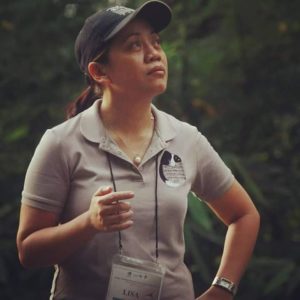New mistletoe species named after Philippine wildlife biologist

Amyema Lisae. (contributed Photo/ Pieter Pelser)
CHRISTMAS came early for Bacolod-based wildlife biologist Lisa Paguntalan.
A new mistletoe species, Amyema lisae, was named after Paguntalan, executive director of the Philippines Biodiversity Conservation Foundation, Inc. (PBCFI).
The rare honor of having a plant named after a wildlife biologist was published in the scientific journal Phytotaxa entitled “A new species of Amyema (Loranthaceae) and a new Gastrodia (Orchidaceae) record for the Philippines from Negros Island.”
Article authors Pieter B. Pelser, Shiella Mae B. Olimpos, Peter O’byrne and Julie Barcelona wrote that the plant was named after Paguntalan to honor her contributions to nature conservation in the Philippines.
“Ms. Paguntalan has been an epitome of a conservationist who is most successful in bringing together stakeholders in the conservation of biodiversity,” said the authors.
Paguntalan was also described as a champion of organizing and involving local communities in conservation programs in many parts of the country.
Paguntalan said it is an honor to have a plant named after her. She has done environment conservation work for 20 years.
“I feel so honored… so much so that this is from my home province in Negros Oriental and described by my two good friends who are great botanists/plant taxonomists,” she said.
“There are so many new species of plants described in the Philippines and many more awaiting description. But to be named after one from top-notch plant taxonomists is a rare honor,” added Paguntalan.
In an interview with Cebu Daily News, Paguntalan said Amyema lisae is endemic to Negros Island, which means that it cannot be found anywhere else in the world.
It can only be found in the protected area of Balinsasayao Twin Lakes Natural Park, which covers an area of more than 8,000 hectares and includes Lake Balinsasayao and Lake Danao in Negros Oriental province.
The natural park covers the municipalities of Valencia, Sibulan and San Jose.
Paguntalan said Amyema lisae does not have a local name. It is also unclear if it is locally common or rare species. The scientists currently classifies the plant as data deficient according to the definition under the International Union for Conservation of Nature (IUCN).
Mistletoes
It is the only mistletoe in the Philippines with the color yellow as most mistletoes in the Philippines are in red and orange colors.
“This discovery is important because it tells us the kind of wildlife that we have in our locality. This tells us about how diverse we area… and adds up to the biodiversity value to a mountain (single-mountain endemics); or in islands (single-island endemics). This adds more importance to Philippines as a mega-diversity country,” she explained.
Paguntalan said mistletoes, popularized by the phrase “kiss under the mistletoe” during Christmas in Western culture, are poorly understood plants.
“They are also food plants for our endemic and threatened sunbirds and flowerpeckers. The critically endangered Cebu flowerpecker, which can only be found in Cebu, feeds on the nectar and fruits of Cebu mistletoe,” said Paguntalan.

Lisa Paguntalan
Conservationist
Born and raised in Mati, Davao Oriental, Paguntalan’s family lived close to a forest and remembers foraging wild fruits with her friends, who are part of the
Mandaya tribe.
“We lived there until I was about 11 years old. It was the place where I first developed my interest in wildlife and nature,” she said.
Paguntalan was raised by a father, who is an engineer and a mother, who is a teacher.
“My Papa used to stop the car and let us out to watch a bird soaring in the sky saying it is the monkey-eating eagle. The name of the eagle was not changed that time. My childhood was filled with memories of my friends and I looking for wild fruits, catching insects or when we gathered flowers for Flores De Mayo,” she said.
This early exposure led her to take up BS Biology degree in 1996 and MS Biology in 2002 in Silliman University in Dumaguete City.
In 2000, she received the BP Conservation Award in London, United Kingdom which jumpstarted her career in wildlife research and conservation science.
“My extensive field research around the country led to rediscovery of supposed extinct species and contributing to the discovery of new species of hawk owls in Cebu and Camiguin,” she said.
While her central interest was in conservation biology, she also developed affinity and passion in its related fields including wildlife and forest protection, wildlife population monitoring, community-based conservation education activities and sustainable tourism.
She was instrumental in the declaration of the Negros Occidental Coastal Wetlands Conservation Area as Ramsar Site.
Paguntalan said the Ramsar Convention on Wetlands of International Importance is an international treaty for the conservation and sustainable use of wetlands. It is named after the city of Ramsar in Iran, where the Convention was signed in 1971.
She also carried out extensive field research and successfully integrated threatened species conservation and management in local government’s agenda at the local, regional and national levels.
These species include the Black Shama, Cebu Flowerpecker and Cebu Cinnamon tree, which can only be found in Cebu.
Paguntalan also serves as consultant on wildlife biology and conservation of national television networks on nature/wildlife programs such as Born to be Wild and Matanglawin.
Paguntalan said it is easy to set aside news such as species discoveries in favor of more controversial topics such as politics and show business.
This is why she reminds the public that biodiversity is life itself.
“We won’t survive without our biodiversity. We won’t have a future if we don’t secure it, if we don’t take care of it,” she said.
Disclaimer: The comments uploaded on this site do not necessarily represent or reflect the views of management and owner of Cebudailynews. We reserve the right to exclude comments that we deem to be inconsistent with our editorial standards.




